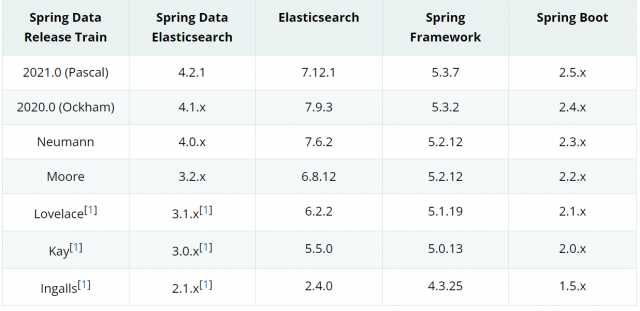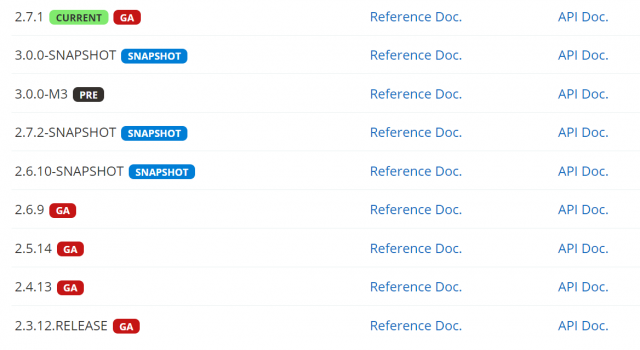问题背景
项目上使用的springboot版本是2.1.1.RELEASE,现在因为要接入elasticsearch7.x版本,参考官方文档要求,需要将springboot版本升级到2.5.14。


本以为是改一下版本号的事,但是升级之后发现服务启动报错了😱。
问题原因
Caused by: org.quartz.SchedulerConfigException: DataSource name not set.从错误信息中可以看出,报错与quartz有关,我们先来顺着异常栈看一下,可以看到是JobStoreSupport.initialize()方法中抛出的错误:
public void initialize(ClassLoadHelper loadHelper,
SchedulerSignaler signaler) throws SchedulerConfigException {
if (dsName == null) {
throw new SchedulerConfigException("DataSource name not set.");
}
...
}
向上溯源可以发现,其初始调用方是这里:
那么这个js对象是什么呢?它是一个JobStore实例,而JobStore其实是一个接口,它有多个实现类:
我们先来打断点看看,这里实际使用到的是哪个类的实例,先将springboot版本改回到2.1.1.RELEASE看看,可以看到使用的是LocalDataSourceJobStore,而当我们使用springboot2.5.14版本时,这里使用的是JobStoreTX是实例化对象。
那么,是什么原因导致两个版本使用了不同的JobStore实现类呢?先来看看js对象是如何初始化的:首先获取org.quartz.jobStore.class属性值,然后通过反射实例化js对象。
显然,在不同版本下,这里获取到的org.quartz.jobStore.class属性值不一致导致了创建了不同的JobStore实现类。
接下来我们看一下项目中与quartz相关的配置,如下代码所示,是一个SchedulerFactoryBean的初始化操作 ,其中设置org.quartz.jobStore.class属性值为org.quartz.impl.jdbcjobstore.JobStoreTX,但是从上面分析中我们知道,在真正创建JobStore实现类时,这个属性值已经发生了变化,由此说明这个值在后期被更改过。
@Configuration
public class ScheduleConfig
{
@Bean
public SchedulerFactoryBean schedulerFactoryBean(DataSource dataSource)
{
SchedulerFactoryBean factory = new SchedulerFactoryBean();
factory.setDataSource(dataSource);
Properties prop = new Properties();
prop.put("org.quartz.scheduler.instanceName", "MyScheduler");
prop.put("org.quartz.scheduler.instanceId", "AUTO");
prop.put("org.quartz.threadPool.class", "org.quartz.simpl.SimpleThreadPool");
prop.put("org.quartz.threadPool.threadCount", "20");
prop.put("org.quartz.threadPool.threadPriority", "5");
// 这里设置org.quartz.jobStore.class属性值为org.quartz.impl.jdbcjobstore.JobStoreTX
prop.put("org.quartz.jobStore.class", "org.quartz.impl.jdbcjobstore.JobStoreTX");
prop.put("org.quartz.jobStore.isClustered", "true");
prop.put("org.quartz.jobStore.clusterCheckinInterval", "15000");
prop.put("org.quartz.jobStore.maxMisfiresToHandleAtATime", "1");
prop.put("org.quartz.jobStore.txIsolationLevelSerializable", "true");
prop.put("org.quartz.jobStore.misfireThreshold", "12000");
prop.put("org.quartz.jobStore.tablePrefix", "QRTZ_");
factory.setQuartzProperties(prop);
factory.setSchedulerName("MyScheduler");
factory.setStartupDelay(1);
factory.setApplicationContextSchedulerContextKey("applicationContext");
factory.setOverwriteExistingJobs(true);
factory.setAutoStartup(true);
return factory;
}
}
而我们从异常栈中可以发现,SchedulerFactoryBean在完成初始化操作之后,执行了afterPropertiesSet()方法,先来看一下这个方法中做了哪些事情:
public void afterPropertiesSet() throws Exception {
if (this.dataSource == null && this.nonTransactionalDataSource != null) {
this.dataSource = this.nonTransactionalDataSource;
}
if (this.applicationContext != null && this.resourceLoader == null) {
this.resourceLoader = this.applicationContext;
}
// Initialize the Scheduler instance...
// 先来看看this.prepareSchedulerFactory()方法中做了什么
this.scheduler = this.prepareScheduler(this.prepareSchedulerFactory());
try {
this.registerListeners();
this.registerJobsAndTriggers();
} catch (Exception var4) {
try {
this.scheduler.shutdown(true);
} catch (Exception var3) {
this.logger.debug("Scheduler shutdown exception after registration failure", var3);
}
throw var4;
}
}
/**
* Create a SchedulerFactory if necessary and apply locally defined Quartz properties to it.
* @return the initialized SchedulerFactory
*/
private SchedulerFactory prepareSchedulerFactory() throws SchedulerException, IOException {
SchedulerFactory schedulerFactory = this.schedulerFactory;
if (schedulerFactory == null) {
// Create local SchedulerFactory instance (typically a StdSchedulerFactory)
schedulerFactory = BeanUtils.instantiateClass(this.schedulerFactoryClass);
if (schedulerFactory instanceof StdSchedulerFactory) {
// 重点来了,这里有一个SchedulerFactory初始化方法
initSchedulerFactory((StdSchedulerFactory) schedulerFactory);
}
else if (this.configLocation != null || this.quartzProperties != null ||
this.taskExecutor != null || this.dataSource != null) {
throw new IllegalArgumentException(
"StdSchedulerFactory required for applying Quartz properties: " + schedulerFactory);
}
// Otherwise, no local settings to be applied via StdSchedulerFactory.initialize(Properties)
}
// Otherwise, assume that externally provided factory has been initialized with appropriate settings
return schedulerFactory;
}
接下来我们进入initSchedulerFactory()方法内部看看具体都有哪些逻辑,这是一个SchedulerFactory初始化方法,它会应用Quartz的一些本地配置属性用于SchedulerFactory初始化:
/**
* Initialize the given SchedulerFactory, applying locally defined Quartz properties to it.
* @param schedulerFactory the SchedulerFactory to initialize
*/
private void initSchedulerFactory(StdSchedulerFactory schedulerFactory) throws SchedulerException, IOException {
Properties mergedProps = new Properties();
if (this.resourceLoader != null) {
mergedProps.setProperty(StdSchedulerFactory.PROP_SCHED_CLASS_LOAD_HELPER_CLASS,
ResourceLoaderClassLoadHelper.class.getName());
}
if (this.taskExecutor != null) {
mergedProps.setProperty(StdSchedulerFactory.PROP_THREAD_POOL_CLASS,
LocalTaskExecutorThreadPool.class.getName());
}
else {
// Set necessary default properties here, as Quartz will not apply
// its default configuration when explicitly given properties.
mergedProps.setProperty(StdSchedulerFactory.PROP_THREAD_POOL_CLASS, SimpleThreadPool.class.getName());
mergedProps.setProperty(PROP_THREAD_COUNT, Integer.toString(DEFAULT_THREAD_COUNT));
}
if (this.configLocation != null) {
if (logger.isDebugEnabled()) {
logger.debug("Loading Quartz config from [" + this.configLocation + "]");
}
PropertiesLoaderUtils.fillProperties(mergedProps, this.configLocation);
}
CollectionUtils.mergePropertiesIntoMap(this.quartzProperties, mergedProps);
if (this.dataSource != null) {
// 重点来了,如果未设置"org.quartz.jobStore.class"属性,就将其设置为"org.springframework.scheduling.quartz.LocalDataSourceJobStore"
mergedProps.putIfAbsent(StdSchedulerFactory.PROP_JOB_STORE_CLASS, LocalDataSourceJobStore.class.getName());
}
// Determine scheduler name across local settings and Quartz properties...
if (this.schedulerName != null) {
mergedProps.setProperty(StdSchedulerFactory.PROP_SCHED_INSTANCE_NAME, this.schedulerName);
}
else {
String nameProp = mergedProps.getProperty(StdSchedulerFactory.PROP_SCHED_INSTANCE_NAME);
if (nameProp != null) {
this.schedulerName = nameProp;
}
else if (this.beanName != null) {
mergedProps.setProperty(StdSchedulerFactory.PROP_SCHED_INSTANCE_NAME, this.beanName);
this.schedulerName = this.beanName;
}
}
schedulerFactory.initialize(mergedProps);
}
也就是说,当我们配置了org.quartz.jobStore.class属性时,在springboot2.5.14版本中会以我们代码中配置的为准,也就是org.quartz.impl.jdbcjobstore.JobStoreTX。
再来看一下springboot2.1.1.RELEASE版本中此处的逻辑,它会直接把org.quartz.jobStore.class属性值设置为org.springframework.scheduling.quartz.LocalDataSourceJobStore,不关心之前有没有设置过该值。
解决方案
明白了问题的症结所在,解决起来就相当容易了,两种方式:
- 去掉
ScheduleConfig配置类中SchedulerFactoryBean对象的org.quartz.jobStore.class属性配置,交由SchedulerFactoryBean#initSchedulerFactor去设置。 - 直接将
ScheduleConfig配置类中SchedulerFactoryBean对象的org.quartz.jobStore.class属性值设置为LocalDataSourceJobStore.class.getName()。
再次启动服务,大功告成✌️。